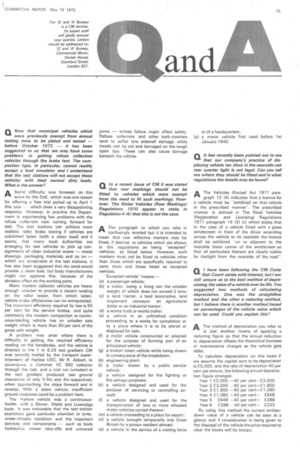Q Now that municipal vehicles which
Page 81

If you've noticed an error in this article please click here to report it so we can fix it.
were previously exempt from annual testing have to be plated and tested — before October 1973 — it has been suggested to us that we may have some problems in getting refuse collection vehicles through the brake test The compaction type, in particular, cannot readily accept a load simulator and I understand that the test stations will not accept these vehicles with their normal dirty loads. What is the answer?
ASome difficulty was foreseen on this score by the DoE, which was one reason for offering a free trial period up to April 1
this year which drew a very disappointing response However, in practice the Department is experiencing few problems with the refuse collectors now coming forward for test. The test stations can achieve more realistic roller brake testing if vehicles are submitted laden (with a clean load) and it seems that many local authorities are arranging for test vehicles to pick up consignments of clean industrial waste — metal shavings, packaging materials and so on — which are acceptable at the test stations. It has also been suggested that dry sand would provide a clean load, but body manufacturers might not approve this, because of the abrasive effect on the working parts.
Many modern collector vehicles are heavy enough unladen to provide a decent reading on the roller tester, from which ladenvehicle brake efficiencies can be extrapolated. The maximum efficiency required by law is 50 per cent for the service brakes, and quite commonly the modern compaction or continuous-loading vehicle has an unladen axle weight which is more than 50 per cent of the gross axle weight.
A problem may arise where there is difficulty in getting the required efficiency reading on the handbrake, and the vehicle is directed to the 1 in 6.25 test gradient. CM was recently invited by the transport superintendent of Harlow UDC, Mr R. Abbott, to accompany a Commer VC 862 collector through the test, and a trial run (unladen) at the test gradient produced rear ground clearances of only 5.5in and 4in respectively when approaching the slope forward and in reverse. With a laden vehicle, insufficient ground clearance could be a problem here.
The Harlow vehicle was a continuousloader, with a Glover. Webb and Liversidge body. It was noticeable that the test station examiners gave particular attention to tyres, under-chassis condition and the important services and components such as body hydraulics, power take-offs and universal joints — whose failure might affect safety. Refuse collectors and other kerb-crawlers tend to suffer tyre sidewall damage, while treads can be cut and damaged on the rough open tips. These can also cause damage beneath the vehicle.




























































































































